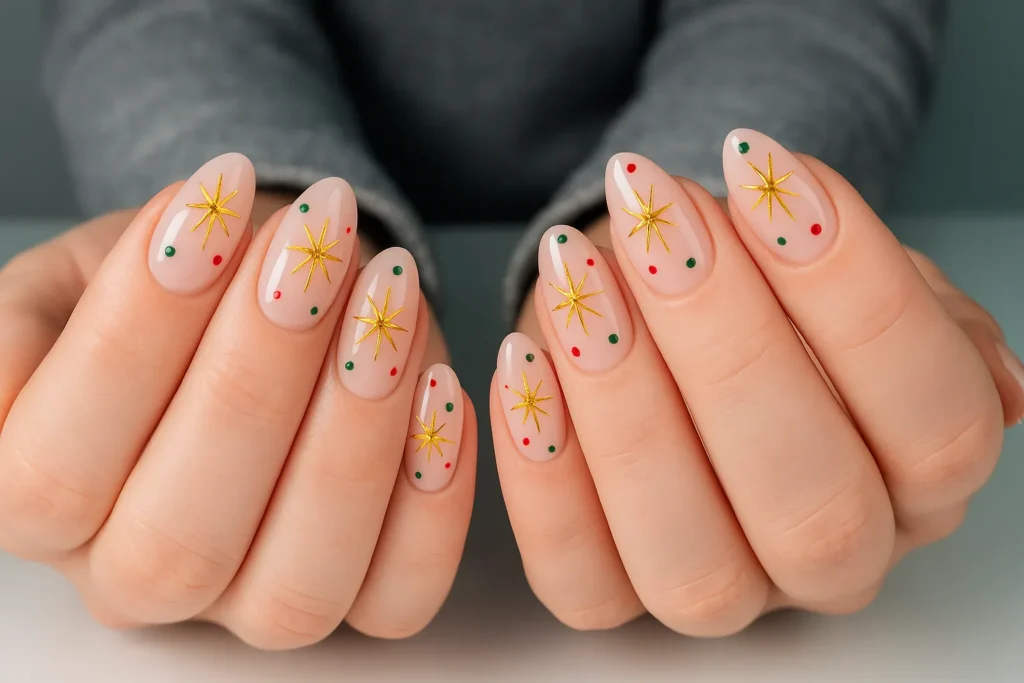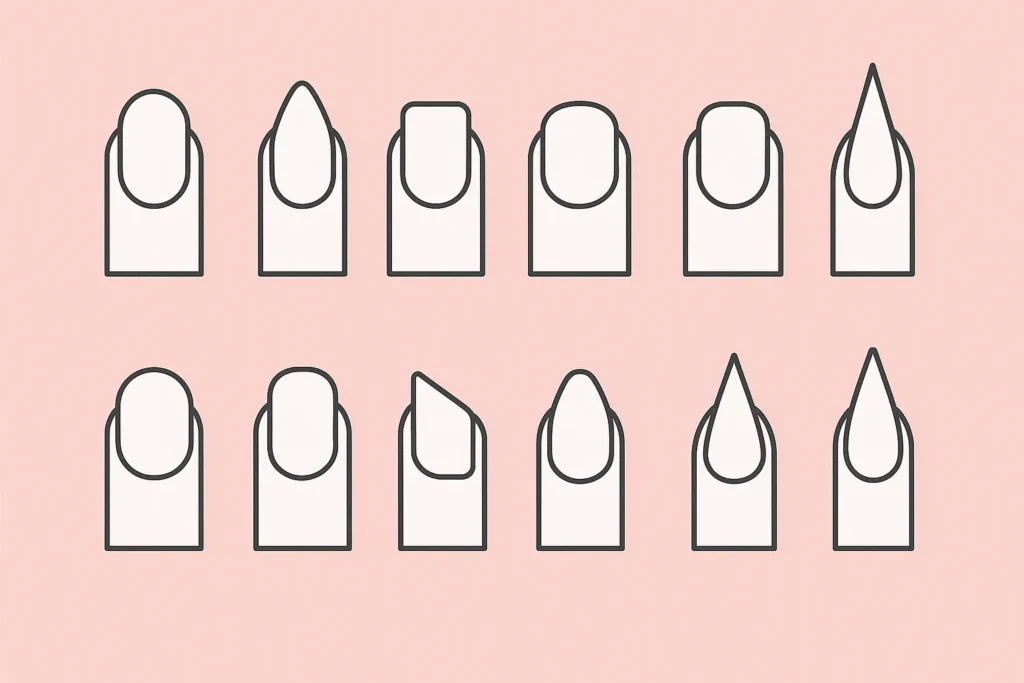Wondering how to know which nail shape is best for you? With so many types of nail shapes out there, picking one can feel overwhelming. Don’t worry – matching a shape to your fingers, nails, and lifestyle is easier than you think. In this friendly guide, we’ll cut straight to the chase with clear, actionable tips. You’ll learn how to assess your finger length and width, pick a flattering silhouette (round, square, almond, etc.), and even try shaping your nails at home. By the end, you’ll feel empowered to choose a nail shape that makes your hands look and feel fabulous.
Step 1: Assess Your Hand and Finger Type
Choosing a flattering nail shape starts with your natural anatomy. Take a good look at your fingers and nails in natural light (OPI recommends pushing back your cuticles to see the true nail bed shape). Here are the key factors to consider:
- Finger length: Are your fingers relatively long or on the shorter side? Round or oval nails can elongate short fingers, making them look slender. For example, OPI notes round nails “elongate your fingers” and slim down wider nail beds. In contrast, if you have long, slender fingers, you can rock almost any shape – even bold ones like square or stiletto – without your hands looking disproportionate.
- Finger width & hand size: Are your fingers wide or narrow? Wide fingers or large hands often benefit from tapered or curved shapes. Tapered styles like almond or oval soften and balance wide nail beds. In fact, experts say almond nails “create the illusion of length” on shorter or wider fingers and are “universally flattering” for many hand types. If you have narrow nails or petite hands, most shapes work – square or squoval nails can add a modern edge if you like clean lines.
- Nail bed shape: Notice the base of your nails. A broad nail bed can support longer styles like coffin or ballerina, whereas a very narrow base might look better with a shorter or tapered tip. For instance, coffin (ballerina) nails are said to be ideal for wide nail beds that can support extra length.
- Short nails: Don’t fret if your nails are short. Short nails can still look polished. Kester Black points out that even very short nails can be flattering with the right shape – try a clean oval or squoval tip for a neat, put-together look.
By gauging these characteristics, you’ll have a solid starting point. For example, if you have short, broad fingers, consider round or oval shapes. If your fingers are long and thin, a square or even a stiletto might be fun. These insights ensure your chosen shape plays up your natural assets.
Popular Nail Shapes and Who They Suit
Once you know your finger/finger-type, let’s explore common nail shapes. Each shape has a unique look and will suit different hands. Below are the most popular styles, with pro tips on who they flatter:
Round Nails
Round nails curve softly along the fingertip edge. They mimic your natural nail line and are very practical. Because there are no corners, round nails catch less on things and resist chips, making them great for busy hands. Importantly, round tips elongate short or wide fingers. As OPI explains, round nails “make fingers look slender”, helping even broad nail beds appear narrower. In style terms, they’re a timeless, understated look – you really can’t go wrong with a round shape. Beauty pro Charlotte Knight even says round nails “look brilliant with any shade of polish”, so feel free to experiment with colors or keep it neutral for everyday chic.
Square Nails
Bright pink square nails with flat, straight edges. Square nails are filed straight across the tip with sharp corners. This gives a bold, modern silhouette that’s perfect for a clean “edgy” look. They work especially well on long, slim fingers – the flat top adds a bit of width, balancing out a narrow hand. OPI notes that if you have “long, narrow nail beds,” square is the way to go. Square nails also make a great canvas for nail art or bold polish colors (think statement red or geometric designs). One thing to keep in mind: those sharp corners can snag or chip more easily, so file carefully (and maybe give a light round to the very edges if snagging is an issue). For a DIY approach, check out our guide on how to shape fingernails square – it walks you through filing that crisp, straight edge step-by-step.
Squoval Nails (Square-Oval)
Squoval nails blend the straight edge of a square with the soft corner of an oval. Think of it as the cool, laid-back cousin of square nails. You get a bit of structure from the straight tip, but the corners are gently rounded so nothing pokes or catches. This hybrid style is universally flattering – Allure reports that squoval nails “seriously suit everyone”. They’re especially great if you have long fingers or a wide palm, as the softened corners balance out the hand’s proportions without looking harsh. Squoval nails are stylish yet practical: they look neat and modern while remaining easy to live with. (If you want to create this shape at home, see our step-by-step on how to file a squoval nail for the perfect result.)
Oval Nails
Oval nails are gently tapered with a rounded tip. Imagine taking a slightly longer nail and rounding off the corners more than a squoval – that’s oval. The result is a soft, egg-like shape that lengthens the nail bed. Oval nails are elegant and graceful. In fact, Kester Black describes them as “slimming and elegant” because the elongated curve stretches the appearance of the nails and fingers. This shape is a favorite for many – it’s classic yet a bit dressy. According to Franklin, oval nails are “best suited for… larger hands,” as the smooth curves add softness to strong features. If you want something more delicate than a square but more striking than round, oval is a perfect middle ground.
Almond Nails
Almond nails are very tapered, narrowing to a rounded point at the tip. Think of an actual almond – a slim shape with a softly pointed end. Almonds look very feminine and elongating. They are universally flattering (as one pro puts it, “almost everyone” can wear almond nails) but they truly shine on shorter or wider fingers. Franklin notes the tapered style “creates the illusion of length” on shorter or broader nails, making hands look longer and slimmer. Be aware: natural nails are often too weak to hold an almond length without help, so people usually reinforce them with gel or acrylic. But if your nails are strong or you use enhancements, almonds give a gorgeous, graceful look. For tips on getting that perfect almond form on natural nails, see our guide to natural almond nails.
Coffin (Ballerina) Nails
Coffin nails (also called ballerina nails) are long, with straight sides and a flat, squared-off tip. They resemble a coffin or a ballerina’s pointe shoe. This trendy, glamorous shape is made for statement manicures – it provides a large canvas for nail art and bold colors. Coffins look best on long nails: Franklin’s experts say they suit “wide nail beds that can support the longer length”. If your nails break easily, consider acrylics or gel extensions, as natural nails alone can struggle to grow this long. The payoff is eye-catching drama, but remember they need gentle handling to avoid cracks.
Stiletto Nails
Stiletto nails are ultra-pointed and dramatic. They start wide at the base and come to a razor-sharp point. These are not for the faint of heart – they’re all about making a statement. Like their almond cousins, stiletto nails help lengthen the look of fingers, especially for longer hands. However, they require very strong nails (or extensions). As Kester Black warns, stilettos are “not great for typing” and need strong support. In practice, that means only attempt stilettos if you’re okay with extra maintenance (and maybe occasional breaks). But if you love edgy, high-fashion nails, nothing says drama like a sleek set of stilettos.
Step 2: Consider Your Lifestyle and Maintenance
Picking a nail shape isn’t just about looks – it has to fit your daily life. Ask yourself how you use your hands:
- Daily activities: If you type a lot, wash dishes, or do hands-on work, sharper and longer shapes (stiletto, long coffin) may be impractical. Kester Black specifically notes stiletto nails are “not great for typing”. In that case, opt for shorter or rounder shapes (like round, squoval, or short square) that are less likely to break or get in the way.
- Nail strength: Some shapes demand sturdy nails. Almond, stiletto, or any very long tapered style usually need reinforcement. Allure observes that “natural nails are often too weak to hold” an almond or stiletto shape on their own, so people use gels or acrylics. If you prefer to stay natural or have brittle nails, stick to robust shapes – think round, squoval, or just a modest almond with a gently rounded point.
- Maintenance: How much upkeep do you want? Sharp corners and points require regular filing to stay even. For a low-fuss mani, round and squoval are winners – they chip less and keep a neat look longer. Square nails can need touch-ups on the corners. Also, longer shapes need careful filing technique to avoid splits, so if you want minimal effort, keep them on the shorter side.
- Style factor: Don’t forget personal flair. Bold shapes like coffin or stiletto pair well with daring colors and intricate art, while classic shapes like round or oval suit minimalist or polished looks. For design inspiration, check out our roundup of the best nail styles (from simple nudes to glittery trends) to see what excites you.
Step 3: Try It Out (DIY or With a Pro)
Now you’re armed with the knowledge – time to put it into action. Here are steps to experiment safely:
- Visualize the shape. You could press your fingertips gently into a piece of paper to outline the nail edge or use tape to sketch the silhouette. This gives you an idea before cutting.
- Decide on length. Always start shorter than you think. It’s easier to file more than to grow nails out quickly. If in doubt, trim nails to a moderate length that still feels comfortable.
- File with care. Choose the right file grit (medium to fine). Always file in one direction to avoid splits. For each side of the nail, file down toward the center: straight for square, angled for almond or oval, etc. After the sides match, shape the tip to close off the nail. (For example, to file a squoval nail, you’d start by filing the sides straight and then rounding off the corners.)
- Check symmetry. Flip your hand around or look in a mirror often to make sure both nails match. OPI suggests this checking step: “Flip your hands and check the symmetry of the curve” when shaping. Go slowly, comparing each nail to the same finger on the other hand.
- Finish up. Buff any rough edges gently. Wash and moisturize your hands and cuticles. Finally, seal your hard work with a base coat and polish or a clear top coat. If you’re not filing by hand, a nail tech can shape and smooth them expertly (just say the shape name — e.g. “square” or “almond” — and they’ll know what to do).
Final Look and Motivation
Choosing the right nail shape is a bit of science but also a fun form of self-expression. Remember, there is no “wrong” choice – the best shape is the one that makes you feel confident. Whether you pick a classic round, a stylish squoval, a glamorous coffin, or a daring stiletto, own it with pride.
Now that you know how to know which nail shape is best for you, go ahead and try it out! Book that manicure, grab your file and polish at home, and shape away. Tag a friend who needs this guide and show off your new look on social media. Most importantly, have fun – your nails are there to express you. You’ve got this!




